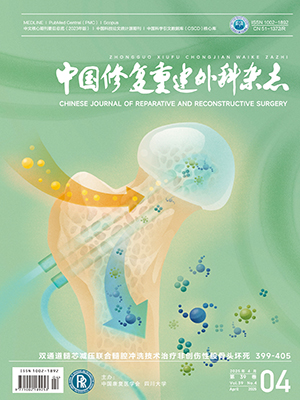| 1. |
郭保逢, 秦泗河, 黄野. 膝关节骨关节炎的保膝治疗进展. 中国修复重建外科杂志, 2018, 32(10): 1292-1296.
|
| 2. |
张星火, A. T. Wild, 于振山, 等 非置换髌骨的非骨水泥型全膝关节置换术中期疗效. 中国修复重建外科杂志, 2008, 22(6): 669-672.
|
| 3. |
黄小敬, 杨胜武, 袁健东. 髋膝关节置换术后假体周围感染的危险因素分析. 中华医院感染学杂志, 2014, 24(6): 1471-1473.
|
| 4. |
彭开勤. 切口愈合的影响因素. 临床外科杂志, 2007, 15(9): 588-589.
|
| 5. |
Sah AP. Is there an advantage to knotless barbed suture in TKA wound closure? A randomized trial in simultaneous bilateral TKAs. Clin Orthop Relat Res, 2015, 473(6): 2019-2027.
|
| 6. |
Newman JT, Morgan SJ, Resende GV, et al. Modality of wound closure after total knee replacement: are staples as safe as sutures? A retrospective study of 181 patients. Patient Saf Surg, 2011, 5(1): 26.
|
| 7. |
Smith EL, DiSegna ST, Shukla PY, et al. Barbed versus traditional sutures: closure time, cost, and wound related outcomes in total joint arthroplasty. J Arthroplasty, 2014, 29(2): 283-287.
|
| 8. |
Maheshwari AV, Naziri Q, Wong A, et al. Barbed sutures in total knee arthroplasty: are these safe, efficacious, and cost-effective? J Knee Surg, 2015, 28(2): 151-156.
|
| 9. |
韦健, 洪定钢. 膝关节置换术患者不同缝合方式对伤口愈合影响的研究. 中国骨与关节杂志, 2016, 5(12): 900-903.
|
| 10. |
Songu M, Aslan H, Denizoglu I, et al. Vocal and ventricular fold lateralization using crossing sutures with the thyroplasty window technique for bilateral vocal fold immobility: long-term results. Acta Otolaryngol, 2013, 133(11): 1201-1206.
|
| 11. |
王亚飞, 李红喜, 廉永云, 等. 运动体位下间断缝合在人工全膝关节置换术中的应用研究. 中国修复重建外科杂志, 2018, 32(4): 400-405.
|
| 12. |
吕增亮, 葛武. 髋膝关节置换术后假体周围感染的危险因素分析. 中国临床研究, 2015, 28(11): 1496-1497.
|
| 13. |
Boddapati V, Fu MC, Mayman DJ, et al. Revision total knee arthroplasty for periprosthetic joint infection is associated with increased postoperative morbidity and mortality relative to noninfectious revisions. J Arthroplasty, 2018, 33(2): 521-526.
|
| 14. |
Ro DH, Kim JK, Kim S, et al. Periprosthetic joint infection does not preclude good outcomes after a revision total knee arthroplasty: a 7-year follow-up study of 144 retrospective cases. Biomed Res Int, 2018, 2018: 2582140.
|
| 15. |
Monticone M, Ferrante S, Rocca B, et al. Home-based functional exercises aimed at managing kinesiophobia contribute to improving disability and quality of life of patients undergoing total knee arthroplasty: a randomized controlled trial. Arch Phys Med Rehabil, 2013, 94(2): 231-239.
|
| 16. |
李玉龙, 翁习生, 董玉雷. 老年全膝关节置换术围手术期并发症影响因素的研究进展. 中华老年骨科与康复电子杂志, 2016, 2(3): 177-180.
|
| 17. |
曹光磊, 沈惠良, 安帅, 等. 高龄患者人工全膝关节置换术的并发症及疗效分析. 中华关节外科杂志(电子版), 2015, (1): 50-54.
|
| 18. |
孙铁莉. 妇科腹部皮肤纵切口缝线选择的探讨. 中国实用医药, 2015, 10(26): 85-86.
|
| 19. |
郭彩霞. 使用 2-0 可吸收线会阴切口皮下美容缝合与传统丝线缝合对产妇康复的影响. 实用妇科内分泌电子杂志, 2015, 2(5): 51-52.
|
| 20. |
伍明. 可吸收线(快薇乔 4/0)连续缝合家兔头皮与普通慕丝线(4/0)间断缝合的优劣对照研究. 长沙: 中南大学, 2007.
|
| 21. |
Amend B, Muller O, Bedke J, et al. Biomechanical proof of barbed sutures for the efficacy of laparoscopic pyeloplasty. J Endourol, 2012, 26(5): 540-544.
|
| 22. |
Nett M, Avelar R, Sheehan M, et al. Water-tight knee arthrotomy closure: comparison of a novel single bidirectional barbed self-retaining running suture versus conventional interrupted sutures. J Knee Surg, 2011, 24(1): 55-59.
|
| 23. |
程飚, 付小兵, 盛志勇. 免疫因素在瘢痕形成和发展中的作用. 中国临床康复, 2002, 6(4): 472-473, 486.
|
| 24. |
Yuan K, Li WD, Qiang Y, et al. Comparison of procalcitonin and C-reactive protein for the diagnosis of periprosthetic joint infection before revision total hip arthroplasty. Surg Infect (Larchmt), 2015, 16(2): 146-150.
|
| 25. |
黄强开, 杜少华, 卫小春, 等. 白介素-6 对于早期诊断关节置换术后假体周围感染的意义. 中华关节外科杂志(电子版), 2012, 6(3): 74-76.
|
| 26. |
郭旗, 郑稼, 金毅, 等. 血沉、C 反应蛋白及 ECT 联合诊断假体周围感染临床研究. 中华实用诊断与治疗杂志, 2010, 24(3): 255-257.
|
| 27. |
Bouaicha S, Blatter S, Moor BK, et al. Early serum procalcitonin level after primary total hip replacement. Mediators Inflamm, 2013, 2013: 927636.
|




